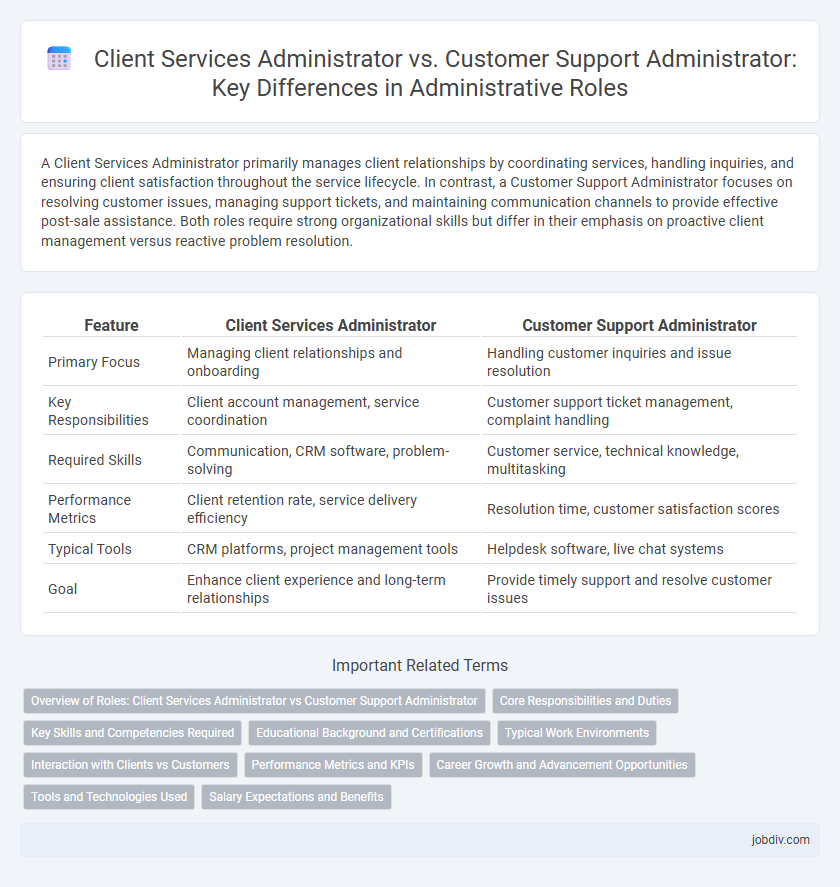A Client Services Administrator primarily manages client relationships by coordinating services, handling inquiries, and ensuring client satisfaction throughout the service lifecycle. In contrast, a Customer Support Administrator focuses on resolving customer issues, managing support tickets, and maintaining communication channels to provide effective post-sale assistance. Both roles require strong organizational skills but differ in their emphasis on proactive client management versus reactive problem resolution.
Table of Comparison
| Feature | Client Services Administrator | Customer Support Administrator |
|---|---|---|
| Primary Focus | Managing client relationships and onboarding | Handling customer inquiries and issue resolution |
| Key Responsibilities | Client account management, service coordination | Customer support ticket management, complaint handling |
| Required Skills | Communication, CRM software, problem-solving | Customer service, technical knowledge, multitasking |
| Performance Metrics | Client retention rate, service delivery efficiency | Resolution time, customer satisfaction scores |
| Typical Tools | CRM platforms, project management tools | Helpdesk software, live chat systems |
| Goal | Enhance client experience and long-term relationships | Provide timely support and resolve customer issues |
Overview of Roles: Client Services Administrator vs Customer Support Administrator
A Client Services Administrator manages client relationships by coordinating service delivery, handling contract documentation, and ensuring client satisfaction through proactive communication. A Customer Support Administrator focuses on resolving customer inquiries, troubleshooting issues, and maintaining detailed records of support interactions to enhance customer experience. Both roles emphasize efficient communication and problem-solving but differ in scope, with client services oriented towards long-term relationship management and customer support centered on immediate issue resolution.
Core Responsibilities and Duties
Client Services Administrators manage client accounts, coordinate service delivery, and ensure client satisfaction by addressing inquiries and resolving issues promptly. Customer Support Administrators focus on troubleshooting, providing product information, and assisting customers with technical or service-related problems through multiple communication channels. Both roles require strong organizational skills and effective communication to maintain positive client and customer relationships.
Key Skills and Competencies Required
Client Services Administrators require strong interpersonal communication, problem-solving abilities, and proficiency in client relationship management software to effectively coordinate service delivery and maintain client satisfaction. Customer Support Administrators must possess technical troubleshooting skills, patience in handling customer inquiries, and expertise with ticketing systems to resolve issues promptly and enhance user experience. Both roles demand organizational skills, attention to detail, and adaptability to manage diverse client or customer needs efficiently.
Educational Background and Certifications
Client Services Administrators typically hold degrees in Business Administration, Communication, or related fields, emphasizing customer relationship management and project coordination skills. Customer Support Administrators often possess certifications such as ITIL or Customer Service Excellence, reflecting a focus on technical support and service quality frameworks. Both roles benefit from continuous professional development in CRM software and conflict resolution techniques to enhance operational efficiency.
Typical Work Environments
Client Services Administrators typically operate in professional office settings within corporate sectors, financial institutions, or consulting firms where direct interaction with clients is essential. Customer Support Administrators commonly work in more dynamic environments such as call centers, retail businesses, or technology companies, handling high volumes of consumer inquiries and support tickets. Both roles require proficiency in customer relationship management (CRM) software and collaboration with cross-functional teams to ensure effective service delivery.
Interaction with Clients vs Customers
Client Services Administrators prioritize personalized interactions, fostering long-term relationships by addressing client needs and tailoring solutions. Customer Support Administrators focus on resolving immediate inquiries and technical issues efficiently to ensure customer satisfaction. Both roles require strong communication skills, but Client Services often involves proactive engagement, whereas Customer Support is more reactive.
Performance Metrics and KPIs
Client Services Administrators primarily track client satisfaction scores, account retention rates, and service delivery timelines to ensure seamless client relationship management. Customer Support Administrators focus on response time, ticket resolution rates, and first contact resolution (FCR) metrics to enhance support efficiency and customer experience. Both roles prioritize unique KPIs that align with their core objectives of client engagement and operational excellence.
Career Growth and Advancement Opportunities
Client Services Administrators often experience faster career growth by managing strategic accounts and developing client relationships, which enhances leadership skills and opens pathways to roles like Client Relations Manager or Account Director. Customer Support Administrators typically advance by honing problem-solving and technical skills, leading to supervisory positions or specialist roles in customer success and support management. Both roles provide valuable experience, but Client Services Administrators generally encounter broader advancement opportunities due to direct client engagement and revenue-focused responsibilities.
Tools and Technologies Used
Client Services Administrators frequently utilize CRM platforms like Salesforce and HubSpot to manage client relationships and track service delivery efficiently. In contrast, Customer Support Administrators often rely on helpdesk software such as Zendesk, Freshdesk, and LiveChat to resolve customer inquiries and monitor support tickets. Both roles increasingly integrate communication tools like Slack and Microsoft Teams to facilitate internal collaboration and streamline workflow processes.
Salary Expectations and Benefits
Client Services Administrators typically earn higher salaries, averaging $55,000 to $70,000 annually, due to their strategic role in managing client relationships and coordinating service delivery. Customer Support Administrators generally earn between $45,000 and $60,000, focusing on resolving customer issues and maintaining satisfaction. Benefits for Client Services Administrators often include performance bonuses and professional development opportunities, while Customer Support Administrators receive comprehensive healthcare plans and flexible work schedules.
Client Services Administrator vs Customer Support Administrator Infographic

 jobdiv.com
jobdiv.com